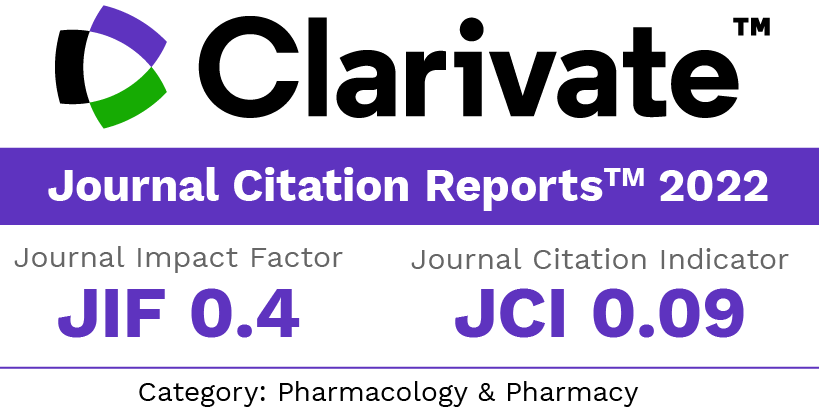Design, development and optimization of buccal bioadhesive tablets of diclofenac sodium for the treatment of odontalgia
Keywords:
Buccal tablet, Diclofenac sodium, D-Optimal design, OptimizationAbstract
The buccal tablets were formulated using the rate controlling polymers such as carbopol 974 P and Hydroxy propyl methyl cellulose K4M (HPMC K4M) or Sodium alginate in various ratios by D-Optimal design. Numerical optimization technique was applied to find out the best formulation by using the software Design Expert. All the formulations were evaluated and it was found that the carbopol 974P have good bioadhesion property but the HPMC K4M controls the drug release. In vitro drug release and release exponent were considered as dependent variables for optimization. The ideal formulation was undergone in vitro diffusion studies and stability studies.Downloads
References
Deshpande, A. A. Rhodes, C.T Shah, N. H. Malick, A. W. Controlledrelease drug delivery systems for prolonged gastric residence: an overview. Drug. Dev. Ind. Pharm. 1996; 22 (6): 531–539.
Singh, B.N. Kim, K. H. Floating drug delivery systems: an approach to oral controlled drug delivery via gastric retention. J. Control. Rel. 2000; 63(3): 235–259.DOI: 10.1016/S0168-3659(99)00204-7
Chavanpatil, M. D. Jain, P. Chaudhari, S. Shear, R. Vavi, P. R. Novel sustained release, swellable and bioadhesive gastroretentive drug delivery system for ofloxacin. Int. J. Pharm. 2006; 316(1): 86–92. DOI:10.1016/j.ijpharm.2006.02.038
Park, K. Robinson, J.R. Bioadhesive polymers as platforms for oral-controlled drug delivery: method to study bioadhesion. Int. J. Pharm. 1984; 19(2): 107–127. DOI:10.1016/0378-5173(84)90154-6
Machida, Y. Masuda, H. Fujiyama, N. Ito, S. Iwata, M. Nagai. T. Preparation and phase II clinical examination of topical dosage form for treatment of carcinoma colli containing bleomycin with hydroxypropyl cellulose. Chem. Pharm. Bull. 1979; 27(1): 93–100.
Nagahara, N. Akiyama, Y. Nakao, M. Tada, M. Kitano, M.Y. Mucoadhesive microspheres containing amoxicillin for clearance of Helicobacter pylori. Antimicrob. Agents Chemother. 1998; 42(10): 2492–2494.
Singh, B. Chakkal, S. K. and Ahuja. N. Formulation and Optimization of Controlled Release Mucoadhesive Tablets of Atenolol Using Response Surface Methodology. AAPS Pharm. Sci. Tech. 2006; 7 (1): E19-E28. DOI: 10.1208/pt070103
Mathiowitz, E. Chickering, D.E.I. Lehr, C.M. Bioadhesive Drug Delivery Systems. Marcel Dekker, New York. 1999.
Robinson, J. R. Mlynek. G. M. Bioadhesive and phase-change polymers for ocular drug-delivery. Adv. Drug Deliver. Rev. 1995; 16(1): 45–50. DOI:10.1016/0169-409X(95)00013-W
Ziyaur Rahman M. Ali, RK Khar. Design and evaluation of bilayer floating tablets of captopril. Acta Pharm. 2006; 56: 49–57.
Anaizi N. H. and Swenson, C. Instability of captopril solution. Am. J. Hosp. Pharm. 1993; 50: 486–488.
Seta, Y. Kawahara, Y. Nishimura K. and Okada, R. Design and preparation of captopril sustained release dosage forms and their biopharmaceutical properties. Int. J. Pharm. 1988; 41(3): 245–254.
Nafee N. A., Ismail F. A., Nabila A. B., Mortada L. M. Mucoadhesive Delivery Systems. II. Formulation and In-Vitro/In-Vivo Evaluation of Buccal Mucoadhesive Tablets Containing Water-Soluble Drugs. Drug Dev. Ind. Pharm. 2004; 30 (9): 995–1004.
Chowdary, K. P. R. Suresh, B. Sangeeta B. and Reddy G. K. Design and Evaluation of Diltiazem Mucoadhesive Tablets for Oral Controlled Release. Saudi Pharm. J. 2003; 11(4): 201-205.
Lachman, L. Lieberman, H. A. and Kanig J. L. The theory and practice of industrial pharmacy. 3rd Ed. Varghese publishing house: Mumbai, 1987; 293-345.
Baumgartner, S. Kristel, J. Vreer, F. Vodopivec, P. Zorko, B. Optimization of floating matrix tablets and evaluation of their gastric residence time. Int. J. Pharm. 2000; 195(1-2): 125-135.
Singh, B. Ahuja. N. Development of controlled-release buccoadhesive hydrophilic matrices of diltiazem hydrochloride: optimization of bioadhesion, dissolution, and diffusion parameters. Drug Dev Ind Pharm. 2002; 28(4): 431-442.
Duchene, D. Touchard, F. Peppas, N. Pharmaceutical and medical aspects of bioadhesive systems for drug administration. Drug Dev. Ind. Pharm. 1988; 14(2): 283–318. DOI: 10.3109/03639048809151972
Lueßen, H.L., Lehr, C.-M., Rentel, C.-O., Noach, A.B., de Boer, J.A.G., Verhoef, J.C., Junginger, H.E., Bioadhesive polymers for the peroral delivery of peptide drugs. J. Control. Rel. 1994; 29: 329–338.
Wang, J.,Tabata,Y., Bi, D., Morimoto, K., Evaluation of gastric mucoadhesive properties of aminated gelatin microspheres. J. Control. Rel. 2001; 73: 223–231.
Xu, G and Sunada, H. Influence of formulation change on drug release kinetics from HPMC matrix tablet, Chem Pharm Bull. 1995; 43(3): 538-550.
Bamba, M., Puisieusx, F. Release mechanism in gel forming sustained release preparations. Int. J. Pharm. 1979; 2(5-6): 307-315.
Downloads
Published
How to Cite
Issue
Section
License
The articles, which are published in this journal, are subject to the following terms in relation to the rights of patrimonial or exploitation:
- The authors will keep their copyright and guarantee to the journal the right of first publication of their work, which will be distributed with a Creative Commons BY-NC-SA 4.0 license that allows third parties to reuse the work whenever its author, quote the original source and do not make commercial use of it.
b. The authors may adopt other non-exclusive licensing agreements for the distribution of the published version of the work (e.g., deposit it in an institutional telematic file or publish it in a monographic volume) provided that the original source of its publication is indicated.
c. Authors are allowed and advised to disseminate their work through the Internet (e.g. in institutional repositories or on their website) before and during the submission process, which can produce interesting exchanges and increase citations of the published work. (See The effect of open access).


















